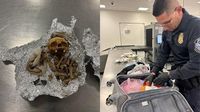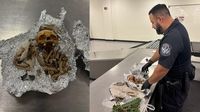Travelers passing through Tampa International Airport on September 19, 2025, probably expected the usual bustle of rolling suitcases, quick goodbyes, and maybe a few delayed flights. What they didn’t expect—nor did the U.S. Customs and Border Protection (CBP) agents—was the discovery of what appeared to be human remains, including a portion of a skull, tucked inside a foil-wrapped duffel bag in a passenger’s luggage. The incident, confirmed by multiple news outlets including The Independent and Fox 13 Tampa Bay, immediately raised eyebrows and questions about how such items ended up at one of Florida’s busiest airports.
According to Carlos C. Martel, Director of Field Operations for CBP in the Miami and Tampa offices, the discovery was made when Agriculture Specialists conducted a routine inspection of a traveler’s bags. The passenger had declared 10 cigars, but a closer look revealed much more: prohibited plants, undeclared cigars, and, most startlingly, a foil-wrapped bundle containing what looked like human bones—including part of a skull. Photos released by CBP, and shared widely on social media, showed gloved officers examining the grim contents, the skull and bones starkly visible through the metallic wrapping.
When questioned, the passenger told officials that the remains were intended for "rituals." The specific nature or cultural context of these rituals was not clarified by CBP, and the agency has not released further details about the passenger’s identity or nationality. The ambiguity surrounding the intended use of the remains has left many speculating about the motivations and background of the traveler, but authorities have been tight-lipped, citing an ongoing investigation.
“At CBP, we never know what baggage may hold, but smugglers should know we’ll always have a bone to pick,” Martel quipped in a social media post, adding a touch of gallows humor to an otherwise unsettling discovery. The post, which quickly went viral, underscored the unpredictable and sometimes bizarre nature of customs enforcement at international airports.
The health risks posed by transporting human remains without proper documentation or containment were not lost on officials. Due to what CBP described as "serious health risks," the items were seized and, according to Martel’s post, destroyed. However, a spokesperson for the Department of Homeland Security (DHS), which is now overseeing the case, declined to confirm whether the remains were actually destroyed, pointing only to the ongoing nature of the investigation. The DHS spokesperson also would not disclose whether the passenger was detained, nor where the traveler was coming from or heading to, leaving key aspects of the story shrouded in mystery.
As reported by Fox 13 Tampa Bay, the case has now been handed over to the Department of Homeland Security, with officials describing it as an "ongoing investigation." The lack of clarity about possible charges, the traveler’s status, and the ultimate fate of the remains has only fueled public curiosity. For now, there is no official word on whether the passenger will face criminal prosecution or what specific laws may have been violated.
The discovery has also put a spotlight on the complex regulations governing the transport of human remains into the United States. According to the Centers for Disease Control and Prevention (CDC), travelers bringing non-cremated human remains into the country must provide a death certificate, unless the remains are cremated or embalmed. All non-cremated remains must be transported in a leak-proof container to prevent exposure to blood and other bodily fluids—a requirement designed to protect the public and transportation workers from potential health risks. While clean, dry bones or bone fragments may not require a permit if they are intended for burial, entombment, or cremation, the CDC notes that a permit may be necessary for remains imported for "any purpose other than burial, entombment or cremation."
In this case, the passenger’s stated purpose—rituals—may well fall into that ambiguous category. The lack of clear documentation or containment, combined with the presence of prohibited plants and undeclared cigars, likely contributed to the decision by CBP to seize and reportedly destroy the items. The agency has not specified what kind of plants were found, nor whether they were connected to the alleged rituals.
The incident at Tampa International Airport is not the first time CBP has encountered unusual or prohibited items in travelers’ luggage. Just last month, CBP officers at Washington Dulles International Airport in Virginia apprehended a Las Vegas woman attempting to smuggle 59 pounds of marijuana out of the country—a bust valued at nearly half a million dollars, according to a press release cited by The Independent. While the Tampa case did not involve narcotics, it highlights the range of items—sometimes shocking, sometimes dangerous—that customs officials are tasked with intercepting.
Traveling with human remains is, in fact, a surprisingly common occurrence, though usually under far more regulated circumstances. Families repatriating loved ones, researchers transporting specimens, and even collectors moving artifacts must navigate a labyrinth of international and domestic laws. The CDC’s guidelines are explicit: “This requirement is intended to protect the public as well as federal, airline, and airport employees from potential exposure to blood and other body fluids during transportation, inspection, or storage of human remains.”
In the absence of further details from authorities, the Tampa case has left the public with more questions than answers. Was the passenger aware of the strict regulations? Were the remains obtained legally, and if so, from where? What kind of rituals required such items, and was there any evidence of criminal intent? For now, officials are saying little, and the investigation continues under the watchful eye of DHS.
What is clear is that the discovery has prompted renewed scrutiny of airport security procedures and the challenges faced by customs agents in distinguishing between cultural practices and potential violations of law. As Martel’s wry comment suggests, the job is unpredictable—and sometimes, the contents of a suitcase can tell a story stranger than fiction.
As the investigation unfolds, both local and federal authorities are expected to provide more information. Until then, the case of the skull in the suitcase serves as a stark reminder: in the world of airport security, you really never do know what’s coming down the conveyor belt.


